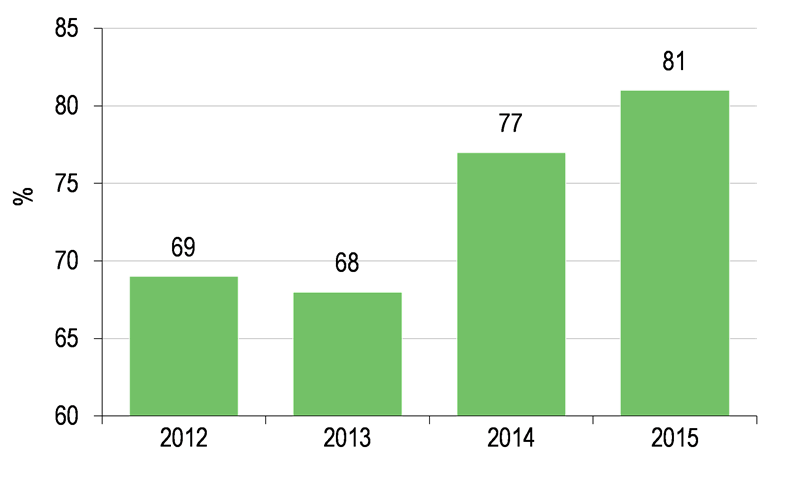Outlook: Still substantial potential to gain share
The overriding observation for STB and, to a greater or lesser extent, other challenger banks is that there is very substantial market share to compete for. The potential remains particularly promising while the major banks are addressing capital issues and focusing on core activities. Based on 2014 data, STB has presented implied market shares of 2.1% in retail/point of sale finance, 0.31% in motor finance and less than 0.1% for asset and invoice finance. It has yet to initiate residential mortgage loans, where the target segment is near-prime loans within an overall market where outstanding loans stood at £1.3tn at the end of 2015 (source: Bank of England).
From a competitive perspective, challenger banks are lobbying for a regulatory regime that provides a more level playing field to allow them to compete with the major incumbent banks. In his evidence to the Competition and Markets Authority (CMA) retail banking market investigation, STB Chief Executive Paul Lynam highlighted four key problems in the market that inhibit change: disproportionate capital requirements for smaller banks (employing standardised risk-based assessments rather than an internal ratings approach); more expensive funding; access to payments infrastructure (challengers have to use the clearing banks); and the proportionate impact of regulation. The extension of the CMA’s time to report is seen by the group as a positive indicator and any recommendations to ease capital requirements or reduce regulatory burden could be positive for STB on a medium-term view, although there are limitations on how far incumbent advantages in the retail and SME market can be countered.
Turning briefly to the macroeconomic background, this remains uncertain, with GDP forecasts for the UK being trimmed in parallel with a more cautious global outlook. The Office of Budget Responsibility (OBR), for example, in its March outlook reduced its central growth forecasts for this year and next by 0.4 and 0.3 percentage points respectively to 2.0% and 2.2%. The result of the EU membership referendum could give rise to additional volatility, but if current OBR and similar forecasts prove a reasonable guide, then continued growth and muted unemployment (between 5.0% and 5.3% forecast over the next five years) would provide a favourable environment for lenders such as STB with the potential for impairments to remain at low levels (mirrored in the relatively low company liquidation and, compared with the post crisis peak, individual insolvency rates shown in Exhibit 6).
Exhibit 6: Company liquidations and individual insolvencies (%) in England and Wales
|

|
Source: The Insolvency Service. Note: Company liquidations expressed as % of average number of active companies in the period and individual insolvencies as % of average estimated adult population.
|
While STB has small market shares, as noted, it is useful to set the scene in terms of UK consumer and SME lending trends. Exhibit 7 shows how consumer credit lending (here excluding credit cards) has strengthened since the financial crisis, which is attributed to both supply and demand; in Q116 demand increased markedly and the Bank of England Credit Conditions Survey indicates that credit scoring criteria loosened significantly, an observation that accords with STB’s comments in relation to unsecured credit. Commenting on its own credit risk management in consumer finance, STB indicates that it has commissioned work on motor finance risk management, developed its unsecured lending methodology and maintained its scorecard in point of sale retail lending during a period of rapid growth.
The growth in car finance through dealerships (Exhibit 8) has been an important contributor to consumer credit growth and STB’s motor finance loan growth has markedly outpaced strong industry figures from the Finance & Leasing Association (FLA) shown here. STB is in the process of extending its offering into prime motor loans; the returns may be lower in this area of the market but it will still provide incremental returns and will allow STB to act as a one-stop shop for dealerships and to offer an alternative to customers who just fail to meet prime criteria. Because of an annual cycle in motor dealers’ arrangement of financing there is unlikely to be evidence of this initiative until 2017. Providing the macro backdrop does not take a significant turn for the worse, the prospects for STB’s motor finance business appear to remain positive. Latest FLA data shows no sign of growth flagging, with the value of new business up 20% and 27% y-o-y in January and February respectively.
Exhibit 7: Consumer credit ex-credit cards
|
Exhibit 8: Car finance through dealerships
|

|

|
|
|
Source: Finance & Leasing Association
|
Exhibit 7: Consumer credit ex-credit cards
|

|
|
|
Exhibit 8: Car finance through dealerships
|

|
Source: Finance & Leasing Association
|
As far as SME lending is concerned, Bank of England data show that growth has only resumed quite recently even though supply is reported to have become more available over the last two years. Subdued demand has been a factor, with the latest SME Finance Monitor reporting that 78% of survey respondents were ‘happy non-seekers’. This perhaps contributes to the rising percentage of successful applications indicated in Exhibit 10, potentially a sign of easing of criteria in some areas but also a degree of normalisation in the market as supply has been increased following the introduction of the Finance for Lending Scheme in 2012, its subsequent extension and, to some extent, the growth in alternative providers.
Exhibit 9: SME stock of lending % change y-o-y
|
Exhibit 10: SME % successful applications
|

|

|
|
|
Source: BDRC SME Finance Monitor
|
Exhibit 9: SME stock of lending % change y-o-y
|

|
|
|
Exhibit 10: SME % successful applications
|

|
Source: BDRC SME Finance Monitor
|
Within STB’s Business Finance activity, real estate is the largest area, split between residential development finance and professional buy to let companies. On our estimates this area would account for nearly 40% of the group loan book in 2018. The early experience in this area has been positive, with no losses incurred and a number of repayments being made ahead of expected dates. The long-term outlook for residential development is seen as favourable given the shortage of appropriate housing stock in the UK. Lending is currently mainly in the South East but the geographical spread is being broadened, while the group keeps a close eye on the market background with a view to responding quickly should the environment become more difficult. On the buy to let side of the business, loans are typically at low loan to value percentages to companies with 30-40 properties earning good returns on equity. These corporate customers are likely to be less sensitive to legislative changes relating to buy to let (interest costs still tax deductible) than individual investors, but, again, STB is monitoring the market closely.
Prospectively, development of the mortgage loan book will be a key element in the expansion of the group loan book and, within our estimate assumptions, could account for 15% of the loan book by 2018. Management see this as having the potential to form a third leg for the business, suggesting further substantial expansion could follow. The growth in mortgage lending we have estimated represents a big step from a standing start in 2016, but a c £400m loan mortgage book would still represent a very small position in the market and an experienced team has been hired to undertake the development of this business.



























